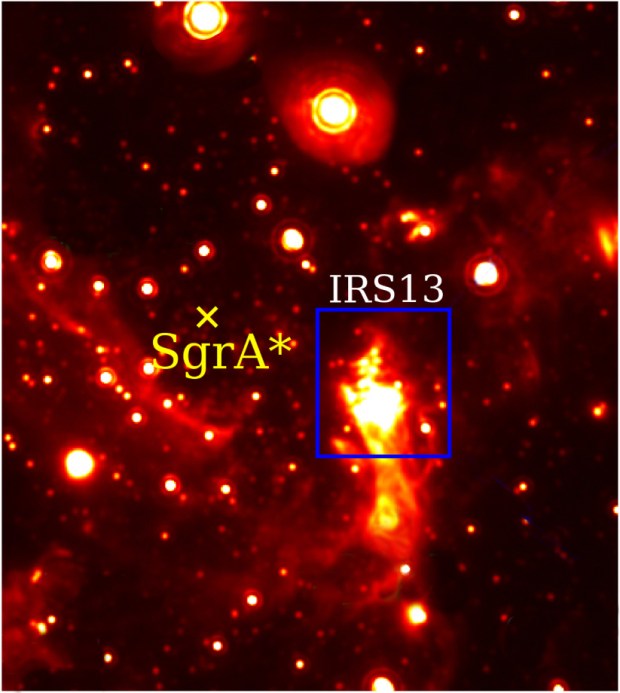
A mysterious and intensely fierce environment resides in the centers of galaxies. Objects orbiting the galactic centers are always subject to falling into the trap of the accretion disks or event horizons of central black holes, which exist in most galaxies. Our own Milky Way Galaxy has a supermassive black hole named Sagittarius A* (Sgr A*) “weighing” some 4.3 million solar masses. Near this central behemoth lie other objects, whizzing around at high speeds. Many are in very close range to Sgr A*, but now astronomers have studied an extremely young star cluster designated IRS13 in the immediate vicinity of Sgr A*. And not only that: The team has also found chemical signatures of ice water from the galactic center!
IRS13 revealed itself and left astronomers in awe just 20 years ago with its surprising existence. The stars within the cluster are estimated to only be a couple million years old at most, quite young by stellar standards (to compare, the Sun is about 4.6 billion years old). Decades ago, newly formed stars less than a light-year away from a supermassive black hole seemed unimaginable. Considering the black hole’s powerful high-energy radiation and violent tidal forces, it’s hardly an ideal birthplace for stars.
Only with recent optical advancements did the international research team obtain what was necessary to properly examine the cluster. “The analysis of IRS13 and the accompanying interpretation of the cluster is the first attempt to unravel the decade-old mystery about the unexpectedly young stars in the galactic center,” says leader of the study and postdoctoral researcher Florian Peißker (pronounced Peissker) from the University of Cologne’s Institute of Astrophysics in a press release.
Are we at the center yet?
Most astronomy enthusiasts are familiar with the main components of the Milky Way: the halo, the disk, and the galactic center. However, for most barred spiral galaxies, the galactic center contains a large disk-like complex of molecular gas and stars, called the Nuclear Bulge (NB) — let’s consider it as a cosmic nesting doll.
The NB surrounds the Nuclear Stellar Disk (NSD; a relatively small disk-like structure), which surrounds the Nuclear Star Cluster (NSC; a much smaller but almost spherical structure), which envelops Sgr A*. The radii of the NSD and NSC are about 490 light-years and 15 light-years, respectively. By comparison, IRS13 is just shy of 0.5 light-years away from the supermassive black hole. This is an exceptionally close distance to such a violent and powerful object and one of the main reasons why scientists are so shocked to find such a young star cluster in this vicinity.
Not until the advent of the James Webb Space Telescope’s (JWST) spectrometer were scientists able to capture key details in its history. With the addition of JWST data, the team was able to get a closer look at IRS13 and found 33 newly formed stars and evidence of ice water! This is a telltale sign related to dusty protoplanetary discs around young stellar objects (YSOs) and is an independent sign of recent star formation.
Peißker and his team applied a model to the data and concluded that the dusty objects in IRS13 do indeed fall under YSO classifications. More specifically, they detected subclasses of both massive- and high-mass-YSOs due to different generations of stars in IRS13. “The star cluster IRS13 seems to be the key to unraveling the origin of the dense star population at the center of our galaxy,” said team member and Masaryk University scientist Michal Zajaček.
Buckle up to the center of the Milky Way
Not only did the team examine the stars’ chemical compositions, but they also examined their trajectories (from recent and past studies). Several debates by research teams later, and it eventually resulted in a consensus on how the densely populated cluster formed. The stars within IRS13 exist in two different generations: one consisting of already-formed stars migrating, and one consisting of stars that formed during the migration. They suggest that the cluster could’ve migrated to its current location with the help of coercing winds from the NSC, the interstellar medium, and the supersonic motion of the cluster — all contributing to a bow shock. As the cluster orbits the black hole, its density increases, causing IRS13 to experience a second episode of star formation — possibly answering the question as to why the younger stars are located at its tip.
“There is [another] star cluster, the so-called S-cluster [a small high-velocity star cluster surrounding the black hole], which is even closer to the black hole and also consists of young stars,” adds Peißker. “They are also significantly younger than would be possible according to accepted theories.” Zajaček also suggests these are the first stellar populations extremely close to the galaxy’s center identified by their ages, ranging from hot main sequence stars to young emerging stars. Now, with better instruments at scientists’ disposal, they can discover and analyze more sources that can better bridge the gap between the direct vicinity of the black hole and regions light-years away.









